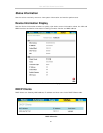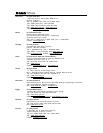
DSL-504T DSL Router User’s Guide
58
network), while the last three numbers denote the host IP address (each computer must have a
unique address to distinguish it on the network). The IP address scheme used in Example #1 can
be used for any LAN that requires up to 253 separate IP addresses (excluding the Router). Notice
that the subnet mask is the same for all machines and the default gateway address is the LAN IP
address of the Router.
It is a good idea to make a note of each device’s IP address for reference during troubleshooting or
when adding new stations or devices.
Using DHCP
The second way to use the default settings is to allow the Router to automatically assign IP settings
for workstation using DHCP. To do this, simply make sure your computers’ IP addresses are set to
0.0.0.0 (under Windows, choose the option Obtain an IP address automatically in the TCP/IP
network component described above). When the computers are restarted, their IP settings will
automatically be assigned by the Router. The Router is set by default to use DHCP. See the
discussion in Chapter 3 for information on how to use configure the Router for DHCP.
Changing the IP Address of the Router
When planning your LAN IP address setup, you may use any scheme allowed by rules that govern
IP assignment. It may be more convenient or easier to remember an IP scheme that use a different
address for the Router. Or you may be installing the Router on a network that has already
established the IP settings. Changing the IP address is a simple matter and can be done using the
web manager (see LAN IP Address in Chapter 5). If you are incorporating the Router into a LAN
with an existing IP structure, be sure to disable the DHCP function. Also, consider the effects of
NAT (Network Address Translation). This is enabled by default but may be disabled in the NAT
menu of the Advanced directory.
An IP addressing scheme commonly used for Ethernet LANs establishes 10.0.0.1 as the base
address for the network. Using Example #2 below, the Router is assigned the base address
10.0.0.1 and the remaining addresses are assigned manually or using DHCP.
Alternative IP Assignment
Host IP Address Subnet Mask Gateway IP
Router
10.0.0.1 255.0.0.0
Computer #1
10.0.0.2 255.0.0.0 10.0.0.1
Computer #2
10.0.0.3 255.0.0.0 10.0.0.1
Computer #3
10.0.0.4 255.0.0.0 10.0.0.1
IP Setup - Example #2
These two examples are only examples you can use to help you get started. Other common private
network IP addressing schemes use a base address of 192.168.0.1 or 192.168.1.1. If you are
interested in more advanced information on how to use IP addressing on a LAN there are numerous
resources freely available on the Internet. There are also many books and chapters of books on the
subject of IP address assignment, IP networking and the TCP/IP protocol suite.


















